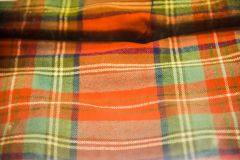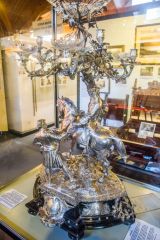
Explore the early history of the clan system and the ancient beginnings of Clan Macpherson through documents and an audiovisual display. Artefacts cover the Scottish Highlands with a special focus on the Macpherson clan throughout history.
You don't have to be a member of Clan Macpherson to enjoy the museum, and many of the displays relate to the wider history of Badenoch. There are so many interesting objects on show that it is hard to pick out highlights, but here are a few that caught our eyes as we explored.

The Black Chanter of Clan Chattan
The Black Chanter, or Feadan Dubh, is a wooden bagpipe chanter thought to be as old as the 13th century. It is one of the clan's most prized possessions and is supposed to possess magical qualities. It is said to have fallen from heaven, causing the cracks that are visible in the wood today. The House of Cluny's prosperity is said to be tied to the chanter.
A Memoir of the 'Forty-Five'
In a wood and glass case is the original handwritten manuscript of the Jacobite Rebellion, written by the Chevalier de Johnstone. The manuscript is open to pages describing the arrival - too late - of Cluny's Regiment of Macphersons, the Duke of Cumberland's brutality in the aftermath of the battle, and how Bonnie Prince Charlie was moved to a succession of remote shielings to hide from the Hanoverians.
During this period a detachment of MacKays burned Cluny House to the ground. One of the few items to be rescued was a heavy iron key, on display near the memoir case.
Near the memoir is a copy of the Prince's targe, a highly decorated sheld. The targe, showing a head of Medusa made of silver, was rescued from the Prince's baggage train after the battle by members of the Macpherson Regiment.

Another item that caught our eye is Old Cluny's Sword, a ceremonial sword given to Col Ewen Macpherson of Cluny upon his retirement as commander of the Inverness-shire Highland Rifle Volunteers. The sword was later sold when the contents of Cluny Castle were auctioned in 1943 but was repurchased in 2000 after a worldwide appeal to members of the Clan Macpherson Association.
Old Cluny had a long and distinguished military career. He fought in the Crimean War, where Macpherson's Regiment formed the famous 'Thin Red Line' at the Battle of Balaclava. One of the museum exhibits is a fragment of the 93rd Regimental colours carried during the battle.
There are several items showing the links between the clan and Queen Victoria, including a royal Stewart plaid given by the queen to John Brown, her Highland piper and ghillie, around 1880. Another item is an armchair used by Queen Victoria when she visited Cluny Castle in 1847.

The Macpherson Epergne
Another item linked to Ewen Macpherson is an exceptional silver epergne, or candelabrum, given to him and his wife Sarah in 1882 to mark their golden wedding anniversary. The ornate silver sculpture illustrates one of the most famous stories in Clan Macpherson history.
A party of Hanoverian soldiers under Sir Hector Munro came to search for 'Cluny of the Forty-Five' following the Battle of Culloden. Cluny quickly disguised himself as a servant and ran out to hold the bridle of Sir Hector's horse during the search.
Finding nothing, Sir Hector asked the 'servant' if he knew where his master is. Cluny replied 'I do not know, and if I did I would not tell you'. Sir Hector gave the servant a silver shilling as a reward for his faithfulness, never guessing that the faithful servant was the Jacobite leader he was seeking.
That's the sort of fascinating story you find again and again in the museum. The story of Clan Macpherson is absorbing and entertaining, and whether you are a clan member or not you will thoroughly enjoy this delightful museum.
The Clan Macpherson Museum is free, though donations are very welcome. There is a small parking area off the A86 (Laggan Road), and the main entrance is on the B9150.












